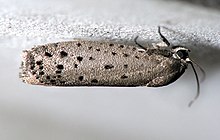| Mimosa webworm | |
|---|---|
 | |
| Scientific classification | |
| Domain: | Eukaryota |
| Kingdom: | Animalia |
| Phylum: | Arthropoda |
| Class: | Insecta |
| Order: | Lepidoptera |
| Family: | Galacticidae |
| Genus: | Homadaula |
| Species: | H. anisocentra |
| Binomial name | |
| Homadaula anisocentra Meyrick, 1922 | |
| Synonyms | |
| |
Homadaula anisocentra, also known as the mimosa webworm, is a species of moth in the family Galacticidae. It is considered a pest of ornamental plants. They attack the leaves of mimosa ( Albizia julibrissin ) and honeylocust ( Gleditsia triacanthos ). [1]
Contents
This species was introduced into the United States from China in the 1940s and likely has two generations per year in the Mid Atlantic region of the United States. [2] The average first occurrence of larvae is after 543 growing degree-days. [2]